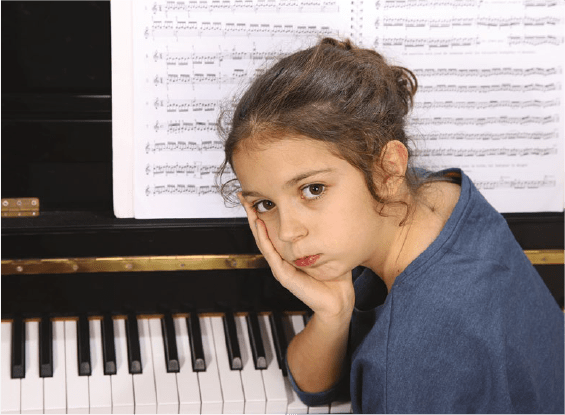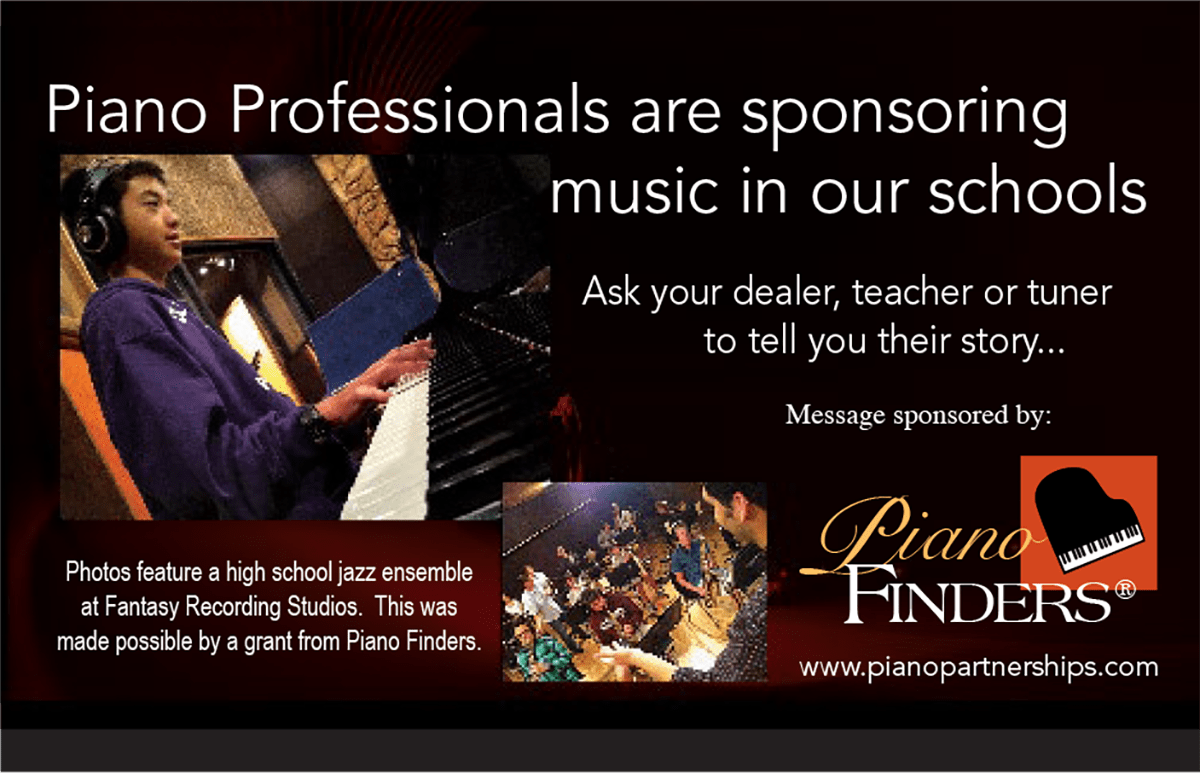
Parents may not want to invest a lot of money in a piano — after all, the child may lose interest — so an older, cheaper piano may seem the logical place to start. However, a bad purchasing decision at this point in a student’s learning tends to be a self-fulfilling prophecy. In many cases a piano that is too old, too small, or simply not good enough will soon become useless to the student. Students don’t have enough experience to distinguish between a bad piano and their own lack of ability. When a piano’s action can’t be regulated to the correct touch, or its strings tuned to a harmonious sound, the student, unable to duplicate what was taught in a lesson, will become frustrated and discouraged, and will lose interest. No amount of practice on such an instrument can overcome its shortcomings. And when you include other factors — the costs of moving, tuning, and repairs; an older piano’s shorter remaining life; lack of warranty protection; the need to hire experts to make repeated trips to evaluate the conditions of various older pianos — a new or more recently made instrument may start to look like a bargain in the long run.

For these reasons, I would encourage the financially able family to look at good-quality new pianos, or better used pianos no more than 15 years old. And with a young talented student, moving up to a quality grand is never a mistake. If an older piano is chosen, it should be one that was of good quality to begin with, and has been restored to like-new condition. If you’re concerned about a child’s continuing interest, I suggest renting a new instrument now, with an option to purchase it later. Most reputable piano dealers offer month-to-month rental programs.
Although good and bad pianos have been made in every decade, and every used piano must be evaluated on its own merits, certain decades or categories of piano frequently found in today’s used-piano market should raise red flags:
Old uprights — These are usually 48" to 60" high and somewhere around 100 years old. Many buyers will purchase an old upright with the idea that it might have antique value, then quickly find out that it doesn’t. In some instances, buyers fascinated by old uprights see them as an opportunity to tinker with and learn something about pianos. There’s nothing wrong with this — as long as a young student is not saddled with it.
Most pianos that are a century old and have not been discarded will need extensive restoration before they can be useful to the student, but few are worth enough to have such work performed on them. Many have difficulty holding a tuning, and/or desperately need new strings, hammers, dampers, or pedal repairs — or all of the above. Parents who purchase these deteriorating instruments as practice pianos for beginners will probably face a constant stream of complaints and subsequent repairs. In most cases, this category of used piano should be avoided for use in serious practice.
Piano BRANDS TO AVOID
Here are some brand names from the 1960s, ’70s, and ’80s — and others from a little earlier and later — that are probably best avoided by students, though some may be acceptable for casual use if carefully serviced or reconditioned.
The names in the left column were some of the many brand names owned and made by the Aeolian Corporation, which went out of business in 1985. Many of these, and other names not listed, were “stencil pianos” — essentially identical instruments with different names applied to them, to meet dealers’ needs. Note that this list applies to the use of these names only during the mid to late 1900s. Some of these names were used in earlier periods on fine pianos, and several are still being used today, but on pianos that have no connection to the ones warned about here.
Aeolian
- Bradbury
- Cable
- Duo Art
- George Steck
- Hallet, Davis & Co.
- Hardman, Peck & Co.
- Henry F. Miller
- Ivers & Pond
- J. & C. Fischer
- Kranich & Bach
- Melodigrand
- Pianola
- Poole
- Vose & Sons
- Winter & Co.
Other U.S.-made brands of the period
- Betsy Ross (by Lester)
- Brambach (by Kohler & Campbell)
- Currier
- Estey
- Grand
- Gulbransen
- Hobart M. Cable (by Story & Clark)
- Jesse French (by Grand)
- Kincaid (by Grand)
- La Petite (by Kimball)
- Lester
- Marantz (by Grand/Marantz)
- Rudolf Wurlitzer (by Wurlitzer)
- Westbrook (by Currier)
- Whitney (by Kimball)
Foreign-made brands of the period
- Belarus (Belarus)
- Daewoo (Korea)
- Horugel (Korea)
- J. Strauss (various countries)
- Sojin (Korea)
- Suzuki (China)
- Tokai (Japan)
Small, cheap, American-made pianos from the 1960s, ’70s, and ’80s — During this period, American companies started feeling the competition from Japanese (and, later, Korean) makers who could undercut their prices. The result was that the few remaining American makers of inexpensive pianos began to cut as much cost as they could from their production. In addition, small pianos, especially spinets, were heavily promoted for their cabinet styling at the expense of their musical qualities.
Spinets, which are 36" to 40" high, have a recessed, or “drop,” action that is connected to the keys with long “stickers” of wood or metal. These actions are difficult — and thus expensive — to repair. Also, during the 1950s and early ’60s, many spinet actions were manufactured with connecting parts, called “elbows,” made of plastic — a technology then in its infancy — which eventually deteriorated and broke off. Installing a set of replacement elbows can cost hundreds of dollars.
Spinets were usually the least expensive entry-level pianos a company would manufacture, and most are not worth repairing. Many of these small, cheap pianos were so poorly designed and constructed that, even when new, and regulated and tuned as well as possible, they played poorly and sounded terrible.
The first wave of pianos from this era began to enter the used-piano market in the 1980s, as the people who originally purchased them began to retire. But many others were passed on to this generation’s children, and now, as those children retire, a second wave of these instruments is entering the market. Even pianos from this period that were well made — and there were some — are now 30 to 50 years old, and so are likely to need some restoration before they will be suitable for the student. Caution should be used to separate those that have potential as good student instruments from those that don’t. (See sidebar for some of the names from this period to be avoided.)
Early offerings from Korean and Chinese makers — Korean pianos made before the early 1990s, and Chinese pianos from before the early 2000s, often exhibit unpredictable, idiosyncratic problems. Quality control was erratic, and wood was often not properly seasoned, resulting in sticking keys and binding cabinet parts. Replacement parts can be difficult to obtain. Especially problematic were the small console pianos without legs (continental furniture style). These pianos tend to be plagued with sticking keys that repeat too slowly due to poor action design, a problem that can’t be inexpensively corrected.
Of course, the used-piano market also offers many well-made pianos from the past, including some with famous names, that are of potential value to a student, but these can also present pitfalls for the unwary. Don’t buy, without professional guidance, a piano that is not thoroughly playable and tunable, with the idea that you can simply have a few inexpensive repairs done once you get the piano home. Get repair estimates before you commit to purchasing any used piano. Every piano technician with any experience has stories of arriving at a tuning appointment to work on a newly acquired piano, only to find an unserviceable instrument. The fact that the instrument may have been rebuilt sometime in the past is not necessarily an advantage. A piano that was rebuilt 40 years ago is no better than a 40-year-old piano that has never been rebuilt, and if the rebuilding job was not competently done, it could be worse — it’s more difficult to properly restore an instrument when certain critical design specifications have been modified due to a past restorer’s mistakes.
Finally, don’t rely on a private seller for important information about the piano you’re thinking of buying. Even the best-intentioned sellers — including ones who play well — tend not to be knowledgeable about piano construction and mechanics, and may have absorbed erroneous information about the instrument, or forgotten important things about its history. Hire a piano technician to inspect any piano you’re seriously considering buying. Sometimes, just a phone call to a technician will be enough to verify whether or not a particular instrument should be considered a serious candidate; if it is, the next step is an inspection by that technician.